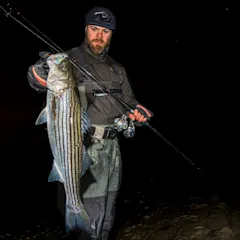_We may earn revenue from the products available on this page and participate in affiliate programs. Learn more ›
_
Best Braided
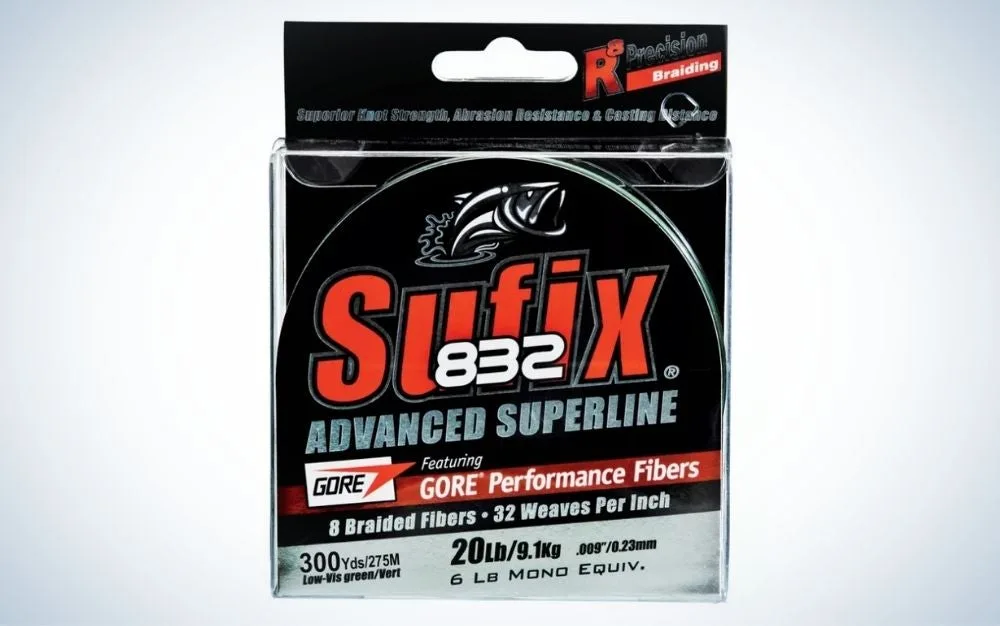
Sufix 832
LEARN MORE
Summary
Sufix 832 provides excellent handling characteristics and strength at a relatively affordable price point.
Best Budget
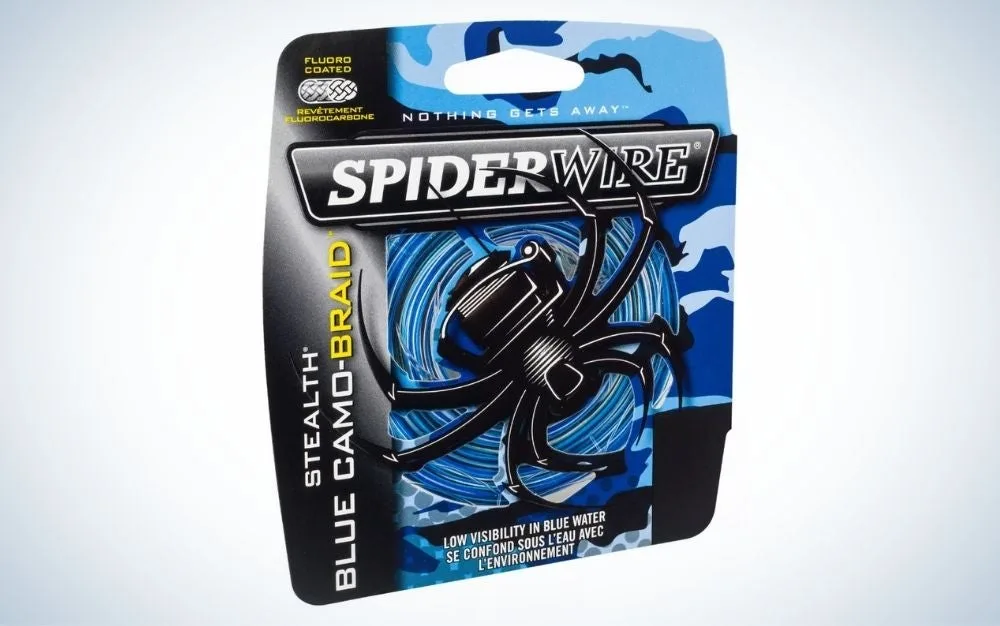
Spiderwire Stealth
LEARN MORE
Summary
Extremely strong, abrasion resistant, and a great choice for those fishing around demanding structure.
Best Monofilament
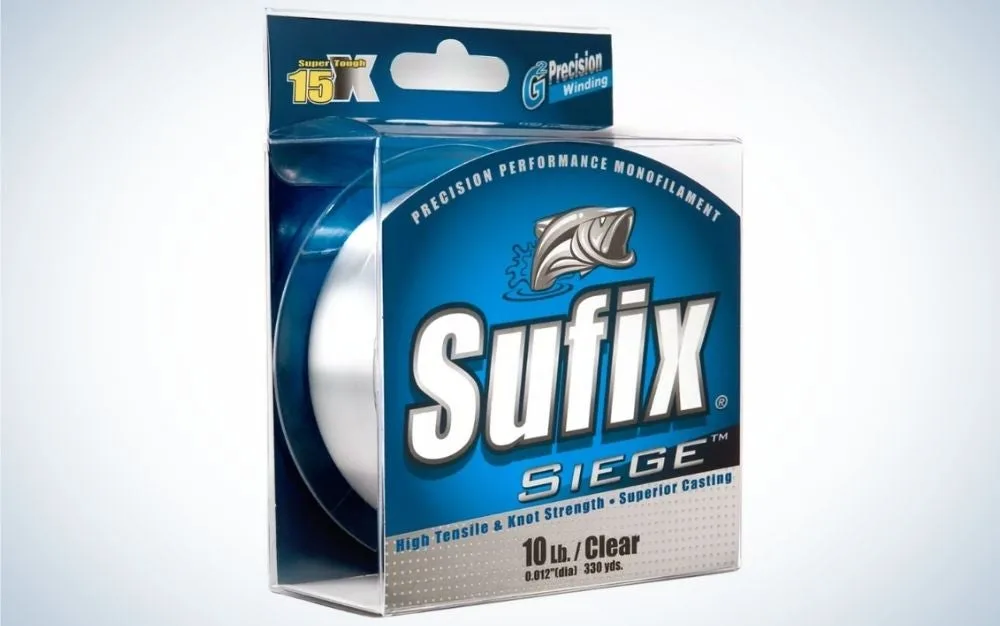
Sufix Siege
LEARN MORE
Summary
Reliable, strong, and durable, Siege is the easiest mono to work with.
Choosing saltwater fishing line can be daunting. As saltwater anglers, there are few pieces of equipment more important than your line. Salty fishermen are tangling with extremely strong fish in highly demanding environments, and their fishing line has to be up to the many challenges associated with both factors. This also means having the right type of line for each situation. It may not be the most exciting or glamorous piece of fishing equipment, but having the best saltwater fishing line will help you hook, fight, and land more fish.
Best Monofilament: Sufix Siege
Best Budget: Spiderwire Stealth
Best Braided: Sufix 832
Best Budget Monofilament Leader: Trilene Big Game
Best Premium Monofilament Leader: Trikfish Saltwater
Best Fluorocarbon Leader: Seaguar Blue
How We Picked the Best Saltwater Fishing Line
My choice for the best saltwater fishing line is based on nearly 30 years of angling experience. I have used an incredible variety of monofilament, braided, and fluorocarbon lines in my fishing. I have used lines of all prices and breaking strengths from $2 to $80 and two to 300-pound test. As a professional fishing writer and photographer, I have talked to thousands of anglers and industry experts over the years and heard a dizzying number of opinions and individual experiences with varying fishing lines
. I have sifted through all this to help make my choices.
I also believe my primary angling pursuit, surfcasting for striped bass, gives me unique insights into line characteristics. I am faced with having to cast very far distances, fighting large fish in strong currents, and also deal with a lot of very tough, sharp, and hard structure- all while fishing at night! As such, I consider fishing line as the single most important piece of my fishing tackle, and take it extremely seriously. When evaluating fishing line, I weigh trade-offs between strength, diameter, abrasion resistance, castability, and price.
The Best Saltwater Fishing Line: Reviews & Recommendations
Best Monofilament: Sufix Siege
Best Monofilament

Specs
Materials and Construction: Nylon monofilament
Pound Test Available: 6-30
Colors Available: Smoke green, clear
Pros
Excellent handling; very supple with limited memory
Very consistent and dependable, a cut above budget lines
Good abrasion resistance for use as a main line
Significantly outcasts budget monofilaments
Cons
Only available in up to 30-pound test
Not that much less expensive than budget braided lines
Sufix lines appear twice on this list because they have been one of the most dependable brands for me. Across both saltwater and freshwater, for a huge variety of species, I have found Sufix to be extremely reliable, strong and durable, and the easiest mono to work with. If you are used to using budget monofilament, you will likely be shocked at how much better Sufix Siege is the first time you tie a knot or take a cast- it is truly on a whole other level.
While it certainly costs more than something like Stren Original, it is far superior in every way. I would argue that Siege is actually more affordable over the long run than cheaper lines, because there is less need to cut back or change lines over the course of a season—it simply lasts a lot longer. One of the significant downsides of using Siege in saltwater specifically is that it is only available in up to 30-pound test. If you need stronger mono line, I’d point you to Ande Premium
(available up to 150-pound test) as another excellent monofilament line, which has landed many world records.
Best Budget: Spiderwire Stealth
Best Budget

Specs
Materials and Construction: 8-strand Dyneema braid
Pound Test Available: 8-250
Colors Available: Blue camo, moss green, and hi-vis yellow
Pros
Super tough, abrasion resistance second to none
Very low cost, great for those who want to try out braid
Extremely reliable build quality
Cons
Not the furthest casting braid, eight-strand braids will substantially outcast Stealth
Tough on the hands, rough texture can cut your fingers
Spiderwire Stealth is extremely strong, abrasion resistant, and a great choice for those fishing around demanding structure. While it substantially outcasts traditional monofilament, it does not cast quite as far as higher strand braids, because it is thick and has a rougher texture. I know many shore and boat anglers who still prefer Stealth over all other premium braids because it is so remarkably tough and reliable. Spiderwire Stealth is also USA made.
The other huge benefit of Stealth it has is how affordable it is. This. Is particularly true if you do not need large quantities: you can purchase 200-yard spools of 30-pound Stealth for less than $20. That will cover a lot of anglers applications (especially when combined with some backing), and you should get years of use out of the line. Spiderwire Stealth is also USA made.
Best Braided: Sufix 832
Best Braided

Specs
Materials and Construction: 8-strand Dyneema and GORE braid
Pound Test Available: 6 -80
Colors Available: Low-vis green, hi-vis yellow, neon lime, coastal camo
Pros
Strong and relatively tough, but also casts excellent
Reliable: you always get exactly the same line, from spool to spool
No knots: I get less wind-knots and tangles with Sufix 832 than other lines
Relatively affordable for a premium braid
Cons
Sufix 832 has a very thin diameter, which makes it less abrasion resistant as some other lines
Choosing the best premium braid for saltwater fishing was extremely difficult. I have tried a lot of different eight-to-10-strand braids. There are many excellent options out there, and I have had good luck with various models from Diawa
, PowerPro
, Berkley
, and P-line
. However, I have come to rely solely on Sufix 832, and I think it is one of the best braided fishing lines ever created.
Sufix 832 is an eight-strand braid, with a single GORE performance fiber which sets it apart from other brands. It casts extremely well, doesn’t tangle, is easy on my hands, and quiet through the guides. Critically, I find that it holds up to my heavy use better than some other brands. I also find that every spool of Sufix 832 has excellent consistency. Compared to other eight-to-10-strand braids, I believe it provides typical abrasion resistance. You will find Sufix 832 on all eight of my primary saltwater spools.
Best Budget Monofilament Leader: Trilene Big Game
Best Budget Monofilament Leader
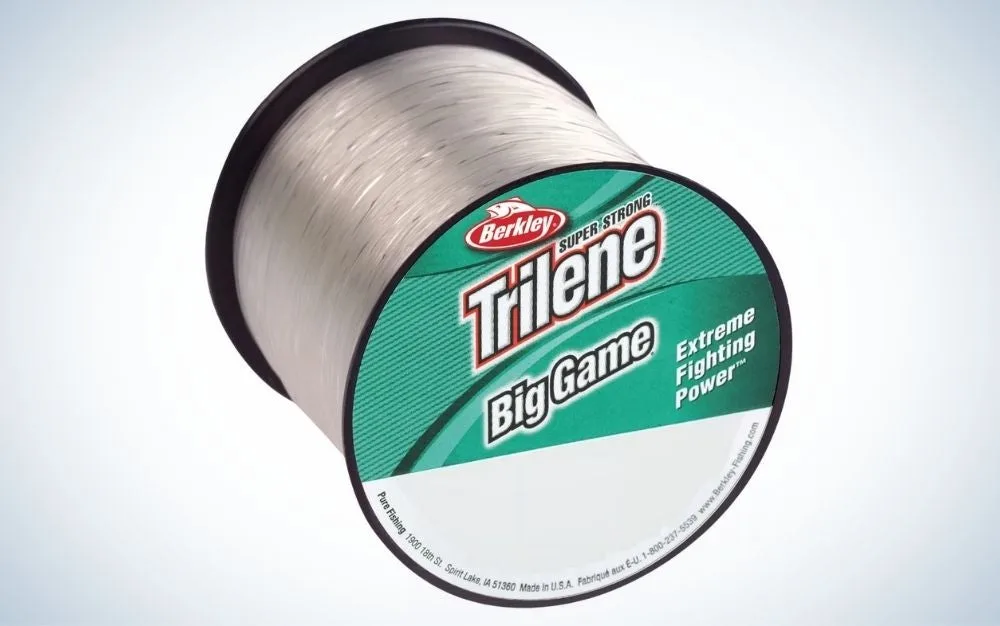
Specs
Materials and Construction: Nylon monofilament
Pound Test Available: 8-60
Colors Available: Solar collector, green, clear
Pros
Excellent value: there are cheaper lines, but they are not of the same quality as Big Game
Strong and very abrasion resistant, but soft enough to tie excellent knots
Available at big-box stores and tackle shops, no need to make a special order
Cons
Suffers from memory, which reduces casting distance
Not the thinnest mono available, can result in drag on your lure or bait
If you are on a tight budget, bulk spools of Trilene Big Game are an excellent choice. They cost less than $10 for over 200-yards, which will last most anglers multiple seasons when used just as a leader material. While the price is great, it wouldn’t mean anything if the line didn’t function well. The good news is Big Game is one of the most rugged lines available. Though it may be a budget option, it has many attributes that make it a strong contender when compared to lines costing three times as much.
Big Game is strong and highly abrasion resistant, and I have found it performs very well even if it gets nicked or otherwise abraded while fighting a fish. Some anglers complain that it is extremely stretchy, and therefore not a great choice as a main line. While this is true, this same characteristic makes it an excellent leader material. The stretch is like a shock-absorber that can help prevent pulled hooks when a fish makes a sudden, hard, run against a tight drag. It’s simply one of the best monofilament leader materials available, at any price.
Best Premium Monofilament Leader: Trikfish Saltwater
Best Premium Monofilament Leader
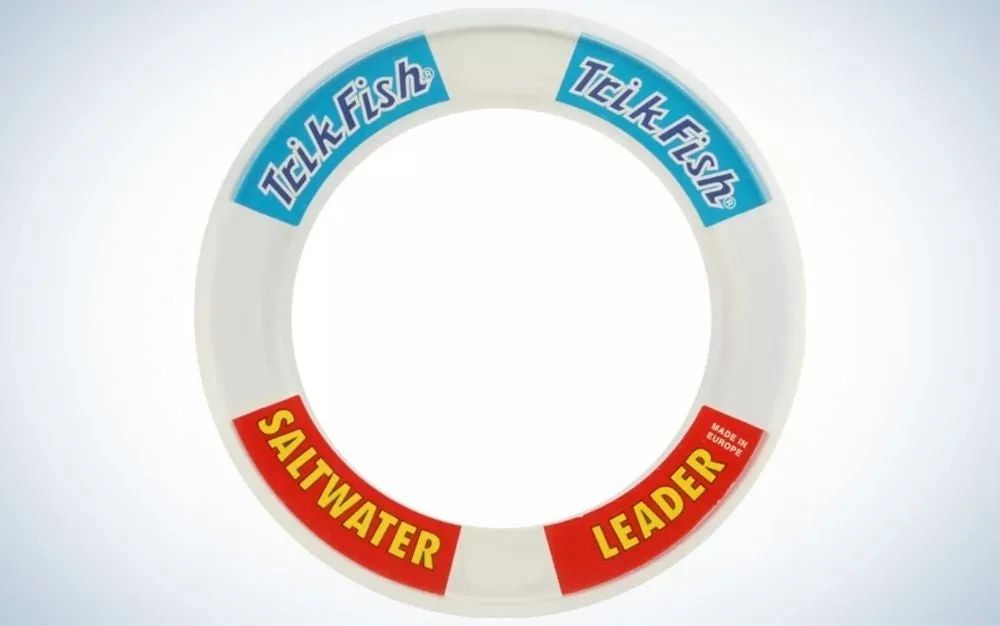
Specs
Materials and Construction: Nylon monofilament
Pound Test Available: 15-100
Colors Available: Clear
Pros
Soft and supple; easy to tie strong knots
Excellent abrasion resistance that I trust in the most demanding situations
Leader spools are convenient to carry, easy to take “on the go”
Very consistent from spool-to-spool
Cons
More expensive than buying bulk budget lines, but still relatively affordable
I like the soft, flexible nature of Trikfish, which is one of the top reasons I have depended on it for so long. Supple lines are easier to tie knots with, which results in better knot consistency and strength. Lines that aren’t as stiff also help maintain lure action, particularly if you are tying directly to the lure. I find that Trikfish is also very consistent and reliable between spools.
While it may be a bit thinner than some other leader materials, it’s really the strength and durability of the line (in addition to how flexible it is) that keeps me coming back. It is also very affordable for a premium leader material, which only helps solidify as my top choice. The fact that it is available in 50-yard wrist spools- which are easy to transport- is another great bonus.
Best Fluorocarbon Leader: Seaguar Blue
Best Fluorocarbon Leader

Specs
Materials and Construction: Flourocarbon
Pound Test Available: 10-80
Colors Available: Clear
Pros
Nearly invisible underwater; worth the price for finicky fish
Very strong and durable, one of the toughest
Tried-and-true formula, well tested on and off the water
Cons
Stiffer than some other fluorocarbons
Expensive; Seaguar is not known for being the most affordable
The fluorocarbon market is competitive and different anglers are often looking for different characteristics in their fluoro. Therefore, it’s tough to choose the best fluorocarbon fishing line for all anglers, and Trikfish
, Ande
, and Hi-Seas
all make excellent products. However, Seaguar Blue has been around for a long time and is one of the most trusted lines for all species from the smallest redfish to the largest tuna.
Seaguar Blue is a bit stiff when compared to some other newer models, and not the thinnest line available, but many anglers prefer this. Seaguar Blue is very consistently made and, as with all good flouro, virtually invisible underwater. Yet, the best attribute of Blue is simple: It is one seriously tough line! To call it ultra-abrasion and impact resistant is almost downplaying how rugged it is. Many of the best anglers around the world trust Seaguar Blue.
What to Consider When Choosing the Best Saltwater Fishing Line
For most saltwater anglers, there are three options for fishing line: monofilament, braid, or fluorocarbon. All have strengths and weaknesses.
Mono: Monofilament fishing line is stretchy, abrasion-resistant, and affordable. However, mono is also thick, has memory (coils heavily), needs to be changed frequently, and is visible underwater.
Braid: Braided fishing line is extremely thin and long casting, has zero stretch, and lasts a long time. However, it is also expensive, not as abrasion-resistant as mono or fluoro, and can cut your hands or fingers if not treated with care.
Flouro: Fluorocarbon fishing line has most of the same characteristics as mono (good and bad), with the substantial bonus of being nearly invisible underwater. However, it’s very expensive and often stiff.
All three types of line
have different sink rates as well. It’s also no secret that different brands and models will vary widely across all the characteristics discussed here, even when made from the same materials and rated to the same strength and diameter.
Given all these factors, most saltwater anglers use a braided main line and a shorter monofilament or fluorocarbon leader. Investing in braid as your main line may be the best upgrade you can make to your tackle, and is often cited as the single most important piece of equipment by many top-level anglers. With fish that have exceptionally good eyesight, it can make sense to upgrade to a fluorocarbon leader instead of monofilament as it is nearly invisible underwater.
Strength
Likely the most important factor in choosing the best saltwater fishing line is strength. The number published on the box or spool is the maximum strength the line can hold under steady strain. Think about tying the line to a doorknob and then gradually pulling slowly until it breaks; that’s essentially what this number means.
Matching line strength to your saltwater species of choice, and the pounds of drag pressure you will be utilizing is critical.
Braid will always be thinner at a given pound test when compared to monofilament or fluorocarbon.
When choosing a line strength, plan for the biggest fish you’ll catch, not the smallest. However, the stronger the line, generally the thicker it will be. This results in reduced casting distance, less sensitivity, more water drag, and reduced lure action—so don’t overdo it.
Braided fishing line in the 20- to 50-pound range is sufficient for almost all anglers, but there are many exceptions. If I could only choose one, I would choose 30-pound. Leader strength is even more variable, but most anglers will find something in the 20- to 80-pound range sufficient.
Durability and Abrasion Resistance
Just because a line is strong, doesn’t mean it’s tough. Do not necessarily use the breaking strength printed on the box as a determinant of how tough the line is. Lines vary widely in durability, even from the same manufacture. Durability and abrasion resistance also generally come at the cost of casting distance: the thicker, tougher, and stiffer a line, the worse it will cast.
Four or eight strand braids as main lines: Generally, four- and five-strand braids are more abrasion resistant when compared to eight-, nine- and 10-strand braids. However, this comes at a significant cost, as they do not cast as well as the higher strand braids. I prefer higher-strand braids, but if you fish heavy structure, you may want to consider lower-stranded options.
Monofilament or fluorocarbon as a leader: Both fluoro and mono have much better abrasion resistance when compared to equal strength braided line. This is why they make such excellent leaders. Many anglers believe fluoro to have the best abrasion resistance, but this is hotly debated; I personally have not been able to prove this. How long your leader should be depends on the species, structure, and tackle you are using. However, many anglers will find a one- to two-foot leader sufficient.
Casting Distance
Casting distance is generally related directly to a line’s diameter (thickness). The reason braid casts better than monofilament at the same breaking strength is because it’s much thinner. Higher-strand braids (eight-12 strands) tend to cast the best than lower strand braids (four-five strands). Shore based anglers will particularly benefit from braids excellent casting distance.
Price
Braided line and fluorocarbon are expensive when compared to traditional monofilament line. However, braided line lasts for years (upwards of a decade if properly cared for). Monofilament will need to be changed frequently, which partially offsets the cost. The lack of stretch and increased casting distance is entirely worth the extra price for braid as your main running line. I would much rather fish a budget rod and reel with quality braided line, versus the very best rod and reel and budget monofilament. Fluorocarbon is definitely pricey, but it is nearly invisible underwater and therefore considered essential by some anglers.
FAQs
Q: Is braid or mono better for saltwater fishing?
This is an easy question to answer: With very few exceptions, braided fishing line is far better for saltwater fishing. Braided line is one of the most ground breaking inventions for saltwater angling in the last 100 years. The lack of stretch, easy of casting, and long-lasting reliability outweigh any disadvantages. It takes a bit of getting used to if you haven’t fished it before (careful of your fingers, and be wary of tangles) but it’s worth it.
Q: How much does saltwater fishing line cost?
This depends entirely on the species you are targeting. For some species, you can get away with line as light as 10 pound test, and use basic monofilament. However, for many moderately sized and large fish, it pays to invest in quality braided line. A spool of braid costs around $10 at the low end, to over $40 at the high end.It’s important to note that hunting large fish with heavy gear also typically requires buying a large quantity of braid: 300 yards or more. This ultimately also impacts the price. If you’re on a budget, I’d buy a good budget braid, like Spiderwire Stealth
, or PowerPro
braid (original), and use a basic monofilament leader.
Q: What color line is best for saltwater fishing?
This is a hotly debated topic. It really depends entirely on the species that you are pursuing. Striped bass, for example, are totally unaware of the line color you’re using, and many anglers prefer very brightly colored braided lines so they can better see where their lure is. However, some anglers who pursue fish with excellent eyesight, like bonefish or sailfish, worry about color turning the fish off. Personally, I don’t worry about it very much, but I do like line that doesn’t bleed color when in use. This is the reason I generally try to get a white saltwater fishing line; no dye to stain my gear or hands.
Best Saltwater Fishing Line: Final Thoughts
Best Monofilament: Sufix Siege
Best Budget: Spiderwire Stealth
Best Braided: Sufix 832
Best Budget Monofilament Leader: Trilene Big Game
Best Premium Monofilament Leader: Trikfish Saltwater
Best Fluorocarbon Leader: Seaguar Blue
To put it bluntly, if you don’t have the best saltwater fishing line for your angling demands, saltwater fish will punish you at every turn. Whether it’s poor abrasion resistance, lack-luster casting distance, over-the-top stretch, or simply spotty craftsmanship, any weaknesses in your line will quickly become apparent when hooking up with powerful saltwater species. For this reason, I cite fishing line as one of- if not THE- most important piece of tackle an angler can buy. Take your decision seriously, don’t skimp where it counts most, and you’ll have a lot more fun on the water this season.
Why Trust Us
For more than 125 years, Field & Stream has been providing readers with honest and authentic coverage of outdoor gear. Our writers and editors eat, sleep, and breathe the outdoors, and that passion comes through in our product reviews. You can count on F&S to keep you up to date on the best new gear. And when we write about a product—whether it’s a bass lure or a backpack—we cover the good and the bad, so you know exactly what to expect before you decide to make a purchase.


